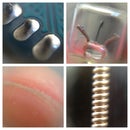Introduction: Mini Maglite LED Hack
I recently found a Mini Maglite flashlight in one of my dad's desk drawers. I replaced the old batteries and attempted to turn it on. As it turned out, the bulb was dead (at that time I didn't realize that I had a replacement bulb). I wanted it working and looking cool, so I went to Radioshack a few blocks away, got a SuperBright blue LED, did some fiddling, and ended up with this...
Step 1: Gathering Materials
First thing you'll want to do is gather the tools and supplies for the project:
Tools
-Electric Drill/Drill Press
-Wire Snips
Parts
-Mini Maglite Flashlight
-SuperBright 5mm LED*
*I went to Radioshack and got a 5mm 2600 mcd SuperBright blue LED (catalog number 276-316. I really don't like going to Radioshack because they mark everything up so much ($4.49 for the LED at Radioshack, compared to $0.33 for a similar one from Jameco), but if I need something quick or want to browse, it's okay.
Step 2: Disassembly
Now we will disassemble the major components in the flashlight. These include the main handle, the batteries, the little screw-in thing in the back, the head, the reflector the front cap, and of course, the original bulb. No tools are necessary for this, it is all screwed together and easily comes apart.
Step 3: Light Comparison
Let's take a moment to compare the original bulb with our new LED. For one, the bulb is glass and is prone to breaking while out of the flashlight, while the LED is, for the most part, a solid hunk of plastic. In addition, the bulb heats up a lot really fast, while the LED will take a while to start warming up. Also, the LED is much brighter than the bulb and does not diverge as rapidly. It's pretty blue color catches attention and is very visible in the dark, as well as light. One thing I noticed later on was that the blue color of the LED is fairly near ultraviolet, so it lights up bright colors quite well, especially highlighters (Florescent dye, I suppose). Now let's get back to business, shall we?
Step 4: Reflector Modification
For the LED to fit snugly in its new home, we will need to bore the hole out in the reflector wider. In my case, because I had a 5mm LED, I bored the hole out a bit larger. I would recommend a drill press for this job if you have on, but if you don't, you can use a standard electric drill.
Step 5: Fitting the LED
Now comes the easy part (as if the rest thus far hasn't been). To make the new LED as nicely fitting as possible, we will cut the leads shorter. We don't want them too short, or else they might not contact the insides of the flashlight properly. I left mine at about 1 centimeter.
Step 6: Putting It All Back Together
Reassembly:
1. Put the batteries back in the handle so you can test for polarity and screw in the end piece.
2. Try the new LED in the two little holes (see image). If you got it right, the LED will light up (Duh). Keep the LED in its spot so you can fit things properly.
3. Place the newly modified reflector back where it came from in the head of the flashlight.
4. Screw the front cap on over the reflector and head. Don't forget the little clear plastic shield.
5. Screw the head onto the handle and turn it on again.
If you did everything right, you should end up with a very bright flashlight that is not good to point in anyone's eyes!
Step 7: Finished Comparison
The first picture shows the flashlight before, and the second shows it after the modifications (same with the front views)...
Have fun with your own!
Participated in the
Let It Glow!













